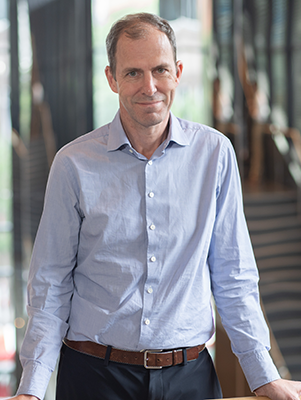Researchers discover early sign of glioblastoma origins
Summary:
A previously unknown mechanism in early brain tumour development could help identify and treat glioblastoma, sooner.
Glioblastoma is the most common and aggressive form of brain cancer, and despite decades of research, the origins of the condition remain largely a mystery. Now, a newly revealed mechanism found by researchers at The Hospital for Sick Children (SickKids) may inform earlier diagnosis and treatment for the complex condition.
Using a specially designed preclinical model, a team of scientists led Dr. Peter Dirks, Senior Scientist in the Developmental, Stem Cell & Cancer Biology program and Chief of the Division of Neurosurgery, and Dr. Akram Hamed, first author and former postdoctoral fellow at SickKids, examined the early stages of glioblastoma for the first time, and published their findings in Nature.
“We had a chance, for the very first time, to see how a brain tumour develops,” says Dirks, senior author on the study. “We believe that by targeting the earliest steps of tumour formation, we will be able to identify new avenues for the treatment of glioblastoma to improve outcomes for patients and families affected by brain cancer.”
A first look into early brain cancer development
Currently, patients with brain cancer are treated with surgery to remove the tumour before undergoing chemotherapy or radiation. When a tumour is removed, patients can choose to share a tumour sample for future research, but because most tumours are removed when they are in a late stage of development, insights into the earlier stages of brain cancer have been limited.
The preclinical model used in the study mapped the process of tumour formation from the earliest steps through to a fully developed tumour mass. The research team discovered a high number of cells in the early stages of brain tumour growth that are similar to neural crest cells, stem cell types that are mostly found in fetal development.
Their findings suggest that these neural crest-like cells may play an important role in tumour growth, since they were very present in the early stages of tumour development but diminished over time – a function that was previously unknown.
The role of injury response in tumour development
In addition to human development, neural crest cells play an important role in healing and regeneration after an injury in some body tissues and organs, such as skin. The research team confirmed that the same is true in brain injury: after the brain is wounded, neural crest-like cells appear in a wound’s location to help the healing process.
Surprisingly, the team discovered that brain tumours create an environment in the brain that mimics the environment of a brain injury on a cellular level. Researchers believe the exposure of genetically vulnerable cells to an injury could potentially lead to tumour formation.
“Cancerous cells are known to hijack processes from healthy cells,” says Dirks. “We believe that cancer cells are derailing a regular wound-response to benefit tumour growth and development instead of healing.”

From early diagnosis to prevention
The research team believes that more insight into the early stages of glioblastoma could lead to earlier diagnosis for patients. “If we can diagnose brain cancer before it really has a chance to get going, we might have the chance to prevent it,” Dirks says.
Future research at the Dirks lab, part of the Arthur and Sonia Labatt Brain Tumour Research Centre, will explore how to translate these discoveries into better treatments and early disease diagnosis for patients.
The research team would like to thank their collaborators Dr. Lincoln Stein, from the Ontario Institute for Cancer Research (OICR), and Drs. John Marioni and Benjamin Simons from the University of Cambridge.
This research was funded by the Canadian Institutes of Health Research (CIHR), the OICR, the University of Toronto, Jessica’s Footprint, the Bresler Family, the Hopeful Minds Foundation, B.R.A.I.N. Child and SickKids Foundation.

